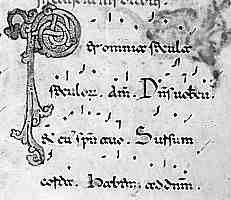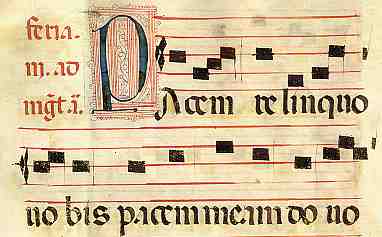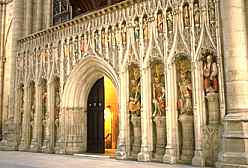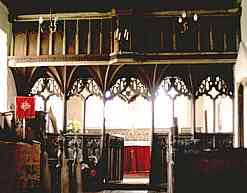



If you are looking at this page without frames, there is more information about medieval writing to be found by going to the home page (framed) or the site map (no frames).
| The Missal (2) | |||
| As knowledge was recorded and sorted into complex compilations, it seems that the culture of the written word became more significant than the culture of memory. Medieval priests had complex mnemonic techniques for remembering the prodigious material of the liturgy, and it was not merely a case of rattling it off by rote. Chaucer had a dig at the less able priests who could only manage this. However, by the later middle ages, it would seem that it was no longer sufficient to indicate a few words of the incipit of a Psalm in a liturgical work. The whole text had to be included. As monasteries became less ferociously enclosed, and with ever increasing number of parish priests, friars and other non-enclosed clergy, there simply were not the long hours of private contemplation in which to cultivate the memory. The written word was developing as a new technology for the mind. | |||
 |
The missal contained not only the words of the mass, but notation for the music. This was also an area where more precise and complete written techniques had developed during the course of the middle ages. Before the 11th century, or thereabouts, symbols called neumes were used to represent musical notes. The system of notation lacked most of the apparatus of modern musical notation, including the prescription of precise tempo and pitch. They represent a kind of mnemonic for singing that was taught and learned orally. | ||
| Musical notation from a 12th century missal executed for the Benedictine nunnery of St Peter, Benevento, Italy (British Library, Egerton 3511, f.173v), by permission of the British Library | |||
 |
Segment of a very large page from a gradual, probably 16th century, from a private collection. | ||
| While the system of square notation for the more accurate transcription of music appeared in the 11th century, the huge choir sheets, capable of being read by the whole choir, seem to very largely date from the later 15th or 16th centuries, and even later as music was manually transcribed in the manuscript tradition centuries after printed books had replaced most other forms of manuscript. This would appear to be another example where the written word (and note) has supplanted oral learning and memory in the performance of the liturgy. The music was inserted into the missal in the same form as that shown in the example above, from a large gradual. An observant friend noted with the example above that the square notes and some other symbols look as if they have been applied with a stamp; the creeping technology of musical literacy! | |||
| Because the missal was essentially a working text for the clergy, rather than a display volume, they tended not to have incredibly lavish decoration. Enlarged decorative initials and rubrics served the practical function of place markers. Some lay persons did own missals, as evidenced from bequests in wills as well as occasional surviving volumes, but it would seem most likely that these were for the use of their private chaplains rather than their own personal use. Nicholas Orme (Orme 1973) has suggested, on the basis of this ownership and an observation by a Venetian visitor to England in 1500 that English people liked to take the Office of Our Lady to church to read there, that lay townspeople may have followed the liturgy using an actual missal or breviary. This would seem to be rather unlikely. Both of these works are very complex texts, unlike the book of hours which is what the Venetian traveller actually implied that they used. They are also quite hefty, although the missal less so than the breviary. The mass was also an enclosed, almost secretive and definitely mysterious, ritual conducted behind the screens of the chancel, out of sight of the laity in the nave even though they could hear it. | |||
 |
 |
||
| At left, the mighty stone pulpitum of Ripon Minster in Yorkshire, at right, the wooden rood screen of the tiny parish church of Coates-by-Stow in Lincolnshire. | |||
| The mass was celebrated in great churches behind a solid, lavishly carved stone screen called a pulpitum. The choir was also ensconsed in this enclosed space in the choir stalls. Even in a small parish church, the priest celebrated mass behind a wooden rood screen. Religious changes over the centuries mean that most of these have disappeared, but they were an essential component of the sacred space of the church. The laity were excluded from this sacred space. The laity took communion only rarely, usually at Easter having undertaken confession. The consecrated wafers were brought to them by a deacon. They did not partake of the wine. In other words, it was not a ritual in which they were included, except as occasional guests outside the door. The capacity of the priest to intercede with God in this way was the defining characteristic of priesthood. | |||
| Continuing issues with heresy had also caused the church authorities to actively discourage the laity from investigating the sacred texts for themselves. In the 15th century, English language Bibles were banned, although there were actually plenty of them about, because it was considered that the laity should not have access to the sacred texts in their own language, for fear they should derive radical interpretations from them. The mass, of course, was conducted entirely in Latin. | |||
| The organisation of the missal is also rather complex; a hypertext which requires a knowledgeable expert to navigate the various threads to extract the text for the day. This concept of the non-linear text is fascinating, but surely represents the development of advanced concepts of literacy among the most educated clerical members of late medieval society. | |||
| |
|||
If you are looking at this page without frames, there is more information about medieval writing to be found by going to the home page (framed) or the site map (no frames). |
|||